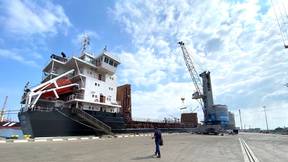A U.S. navy destroyer sailed near islands claimed by China in the South China Sea on Friday, drawing a warning from Chinese warships to leave the area.
The U.S. action was the latest attempt to counter what Washington sees as Beijing's efforts to limit freedom of navigation in the strategic waters, U.S. officials said.
The Chinese Defense Ministry called the move "illegal" and "provocative," saying that two Chinese warships had warned the U.S. destroyer to leave.
The guided-missile destroyer USS Decatur challenged "excessive maritime claims" near the Paracel Islands, among a string of islets, reefs and shoals over which China has territorial disputes with its neighbors, the officials said, speaking on condition of anonymity.
The latest U.S. patrol, first reported by Reuters, is expected to anger Beijing and could further escalate tensions over the South China Sea. The destroyer sailed within waters claimed by China, close to but not within the 12-nautical-mile territorial limits of the islands, the officials said.
The Pentagon said the Decatur "conducted this transit in a routine, lawful manner without ship escorts and without incident." One official said the ship, which sailed near Triton and Woody Islands, was shadowed by three Chinese vessels and that all interactions were safe.
The White House confirmed the Reuters report.
"This operation demonstrated that coastal states may not unlawfully restrict the navigation rights, freedoms and lawful uses of the sea that the United States and all states are entitled to exercise under international law," White House spokesman Josh Earnest said at a news briefing.
It was the fourth challenge that the United States has made to what it considers overreaching maritime claims by China in the South China Sea in the past year, and the first since May.
China, Washington's main strategic rival in Asia, claims almost the entire South China Sea, through which about $5 trillion worth of trade passes each year. The United States has criticized Beijing's build-up of military facilities in the sea and expressed concerns they could be used to restrict free movement.
China has a runway on Woody Island, the site of the largest Chinese presence on the Paracels, and has placed surface-to-air missiles there, according to U.S. officials. Taiwan and Vietnam also have claims on the Paracels.
In the last three U.S. freedom-of-navigation operations in the South China Sea within the last year, U.S. warships cruised within 12 nautical miles of islands claimed by Beijing. The actions drew angry responses from China, which has accused the United States of stirring up trouble there.
The latest operation comes just after the volatile president of the Philippines announced, during a visit to China, his "separation" from Washington and realignment with Beijing. The Philippines has been a key ally of the United States and a territorial rival of Beijing in the South China Sea. Rodrigo Duterte took office as Philippine president in June.
Duterte's announcement on Thursday was a significant turnaround after a tribunal in The Hague ruled that China did not have historic rights to the South China Sea in a case brought by the previous Philippine administration and strongly backed by the United States.
But in Washington a person close to the matter said the latest naval operation was not timed for Duterte's China visit this week and that planning for the patrol had long been in the works.
U.S. officials have said they will continue such operations despite objections by Beijing.
"The U.S. Navy will continue to conduct routine and lawful operations around the world, including in the South China Sea, in order to protect the rights, freedoms and lawful uses of sea and airspace guaranteed to all. This will not change," Chief of Naval Operations Admiral John Richardson said during a trip to China in July.
Rival Claims
Brunei, Malaysia, the Philippines, Taiwan and Vietnam all have rival claims in the South China Sea, but Beijing's is the largest. It argues it can do what it wants on the islands it claims as they have been Chinese since ancient times.
The last U.S. freedom-of-navigation operation in May went within 12 miles of Fiery Cross reef in the Spratly Islands and China scrambled fighter jets in response.
In January, a U.S. destroyer went within 12 miles of Triton Island, and China called the action "irresponsible and extremely dangerous."
U.S. officials have said the operations will continue despite Beijing's protests, but the Obama administration has been criticized in Congress for not conducting them more regularly and robustly.
Greg Poling, a South China Sea expert at the Center for Strategic and International Studies think tank, said the administration was likely to face further criticism after opting for relatively uncontroversial challenges to China in all of its freedom-of-navigation operations in the past year.
"They will have essentially performed the same FONOP, meaning an objection to China's demand for prior notification, four times in a year," he said.
"That is not only redundant, but it does nothing to put a spotlight on the other, much more worrying, restrictions China is placing on freedom of navigation."
China has been placing more serious restrictions on movement, he said, around artificial islands China has built on reefs in the Spratly chain, notably Mischief Reef.
(By Idrees Ali and Matt Spetalnick; Additional reporting by David Brunnstrom and Jeff Mason; Editing by Chizu Nomiyama and Jeffrey Benkoe)

